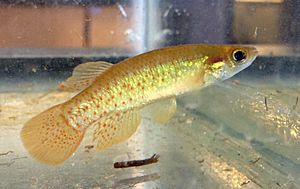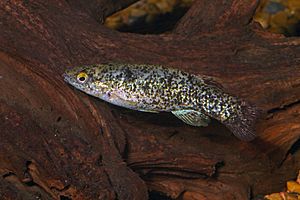Golden topminnow facts for kids
Quick facts for kids Golden topminnow |
|
|---|---|
 |
|
| Conservation status | |
| Scientific classification | |
| Synonyms | |
|
The golden topminnow (Fundulus chrysotus) is a small, colorful fish found mainly in the southeastern United States. It lives in many places, from Kentucky and Ohio all the way down to Florida. Even though it lives in a large area, its favorite homes don't change much.
This tiny fish eats food floating on the water's surface, especially in areas with lots of plants. Golden topminnows usually lay their eggs in late spring and early summer. Their babies grow up quickly, but the fish themselves don't live very long. The golden topminnow is not an endangered species, so it doesn't have a special protection plan right now.
Contents
Where the Golden Topminnow Lives
The golden topminnow lives across the southeastern part of the United States. You can find it from the Santee River in South Carolina all the way west to the Trinity River in Texas. It also lives in the Mississippi area, stretching north to Kentucky and Missouri.
Further south, it's common in the Lower Coastal Plain and scattered throughout Florida. Sometimes, it's even seen further northwest, in places like Oklahoma and Missouri. Outside of these main areas, the golden topminnow is much harder to find.
What the Golden Topminnow Eats and Who Eats It

The golden topminnow eats many different things, from water plants to insects that fall into the water. But mostly, it eats small water bugs. Scientists studied what these fish eat in Lake Seminole, Florida-Georgia.
They found that golden topminnows eat a little bit of water plants. But they eat a lot more water bugs like snails, tiny seed shrimp, mayflies, water beetles, and midge flies. They don't eat other fish. Their favorite foods are seed shrimp and midge larvae. Water beetles and mayflies are also part of their diet.
Because the golden topminnow is a small fish that eats tiny things, many bigger animals like to eat it. These predators include the largemouth bass, redear sunfish, bluegill sunfish, and bluespotted sunfish.
Golden topminnows can also live in water with different amounts of salt. They can survive well in water with a little salt, like 7% or 14% salinity. At 21% salt, most still survive. But if the water gets too salty, like 28% or 35%, they have a hard time living. This ability to handle some salt helps them live in coastal and brackish (slightly salty) waters.
People can affect golden topminnow populations. Pollution in their habitats and changing marshlands into farms are some of the main human impacts.
Life Cycle of the Golden Topminnow
Golden topminnows breed from April to July, and sometimes even as late as September. During this time, the male fish swims in circles around the female. He might also bob his head up and down.
The female lays her eggs one by one. She places them on the roots of floating plants or other stringy materials. Then, the male fertilizes each egg. After the eggs hatch, the baby fish (larvae) rest on leaves or on the bottom. They grow quickly and become adults in about 10 months.
When they are grown, golden topminnows are slender with a rounded tail fin. Their mouth is small and points slightly upwards. Their top fin is set far back on their body. During breeding season, males grow special prickly bumps on their sides and fins. The golden topminnow usually lives for about 2 years.
Protecting the Golden Topminnow
There isn't a special plan to protect the golden topminnow right now. This is because it is not considered an endangered or threatened species.
See also
 In Spanish: Fundulus chrysotus para niños
In Spanish: Fundulus chrysotus para niños


